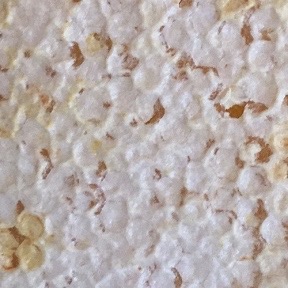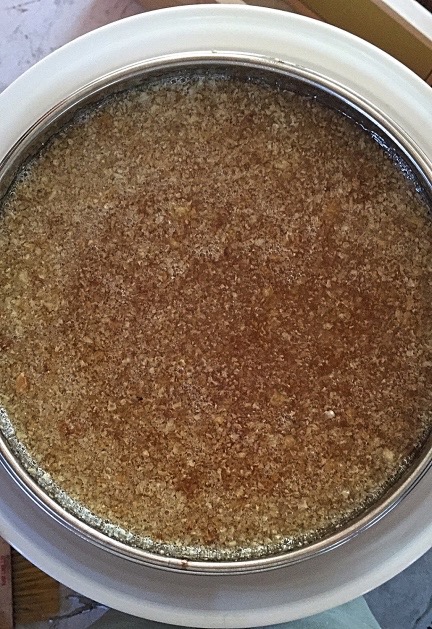Twelve frames of honey — so far.
I spent about two hours this morning in one of my beehives. I’ve got nine of them these days and need to open each one before September month-end to harvest excess honey and begin pre-winter care. In all honesty, the sooner I get the honey out, the better off I’ll be; I know how hard it is to extract honey once temperatures drop.
This Morning’s Bee Encounter
The hive I did this morning has two supers: one deep and one medium. It’s extremely crowded; the bees don’t seem to fit inside — many of them are clustered on the front of the hive at night and during the day. I thought it might be because they were preparing to swarm, but when I opened the hive, I didn’t see any queen cells. What I did see, however, was that the medium super on top was filled with ten fully-capped honey frames. Wow!

Capped honey frame. This is what honey looks like when it’s ready for harvest. It’s capped with wax that needs to be scraped away before extraction.
I took six of them. I was only going to take three, but as I worked with the bees, they got really pissed off and, in turn, got me really pissed off. I had to go back to the house to put on boots after getting stung on the ankle through my thick socks. While I was there, I fetched three more empty medium frames and swapped them for full ones.
Part of the reason they got so angry is my fault — I’m a hands off kind of beekeeper so there’s lots of burr comb to scrape off when I finally get into a hive. And in preparation for winter, I’m dusting them with sugar. That means taking every single frame out and sprinkling home-made powdered sugar on each side. Dusting the bees with powdered sugar is a chemical-free way to help reduce varroa mites; as the bees clean the sugar off, they also dislodge mites which fall through the screened bottom board and can’t get back up into the hive. I can’t use off the shelf powdered sugar because of additives; instead, I grind regular sugar to a powder in a blender.
I debated adding another super to the hive, but with six new empty frames, it didn’t seem to make sense. Besides, the only equipment I have left is a deep super with frames and I hate to put deep supers on top of mediums, especially this late in the season.
This Year’s Harvest So Far

A view looking down into my extractor with two medium frames in place. The frames spin to extract honey by centrifugal force. The extracted honey runs down the inside of the extractor and accumulates at the bottom. A valve allows the honey to be poured out.
The six medium frames I pulled out today are only part of my harvest so far. I also pulled two medium frames and four deep frames from hives back in July. Together, that could come out to 5-6 gallons of honey.
Because it was warm and because I have a new extractor I was dying to try, I decided to start extracting honey today, too. The extractor is a budget model with a hand crank that holds two frames at a time. But, as you might imagine, I wasted no time automating it. I bought an adapter for my drill and use it instead of the crank handle to spin the frames. When the frames are well balanced, it works very well and I can get some good speed going. But when they’re not, there’s a good amount of wobble at high speeds. This is something I’ve learned to deal with over the years.
When the level of honey in the extractor reaches the bottom of the frames, it needs to be poured out before I can extract any more. I managed to get the six frames I pulled today extracted and start on two more.


A closeup look at full/capped (left) and uncapped/extracted (right) cells on a honey frame.

From the extractor, the honey goes into a series of two stainers that strain away the wax cappings, which is what you see here.
Because I use an uncapping fork instead of a hot knife, there’s lots of wax in my extracted honey. Right now, I’m waiting for it to get through the two layers of strainers and into my storage bucket. I hope to extract the rest tomorrow. I’m hiking in the morning, but should be able to do it in the afternoon.
And yes, I’ve seen Hive Flow. But no, I don’t think it’s a good idea for serious beekeepers. Too complex, too costly, and too likely to fail. I would definitely love to chat with someone who has been using one for at least a year, though.
More Bee Stuff to Come
This is just the start of harvest for me.
Although I have two trips scheduled over the next week or so — when cherry season ends, I don’t spend much time home — I hope to get into the other eight hives early in the mornings when I get back. I really hate sweating my brains out in a bee suit on a hot summer day, so I go in when it’s cool, even though that’s when most bees are “home.” My comfort trumps their rest. They should be glad I don’t open them weekly or biweekly like so many backyard beekeepers do.
The last time I open the hives for the winter will be in October. That’s when I’ll check food stores, add more honey frames if necessary, and give the bees some medication for varroa and nosema. I don’t insulate my hives, but I do make sure they have good ventilation for the winter months. Last year four out of six hives survived the winter and one of the ones that didn’t make it entered winter pretty weak anyway so the loss was no surprise. If 50% of my hives survive each winter, I’ll be in good shape each spring.
I sell my honey in jars suitable for gift giving. Buying my honey is a great way to support this site and my beekeeping activities. You can learn more at Maria’s Malaga Honey.
I’d like to expand my beekeeping activities — especially after this very good year. But I’ve learned that I can only support 3 to 5 hives on my property, due to dry summers with little forage. This summer was unusual because it rained a lot though July and there were more wildflowers for a longer period than usual. I think my garden helped, too — the sunflowers were seriously out of control here. So I have five hives at home and four on a trailer up Squilchuck Canyon, not far from a cherry orchard where there’s lots of water and wildflowers/flowering weeds. If I expand much more, I’ll need another trailer and another place to put my bees for the summer.
Something to think about.
Discover more from An Eclectic Mind
Subscribe to get the latest posts sent to your email.

Fascinating post. I had no idea about the complexity of hive maintainance and honey extraction.
My own dilemma at the moment is how to control a plague of wasps without harming the bees (also very numerous this year).
The wasps get under the tiles and into voids in the roof space and make huge nests. When they become bothersome I spray their entrance holes with ant powder administered through a hollow fibreglass fishing rod attached to a presssurised garden spray container. The rod allows the user to be well back from the very pissed-off wasps. Usually a single treatment sorts them out but this year I have found some nests recovering and then thriving again.
It is likely that the treatment harms bees too, so I try to do the spraying in the early evening.
We had a huge bee swarm in early summer but this was successfully collected by a local enthusiast with a temporary ‘collecting hive’.